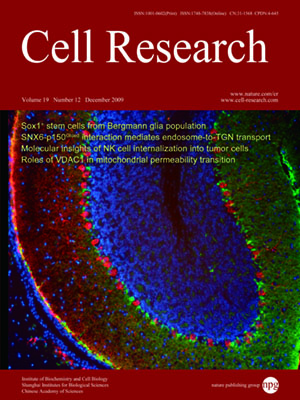
Volume 19, No 12, Dec 2009
ISSN: 1001-0602
EISSN: 1748-7838 2018
impact factor 17.848*
(Clarivate Analytics, 2019)
Volume 19 Issue 12, December 2009: 1363-1376
ORIGINAL ARTICLES
Outer membrane VDAC1 controls permeability transition of the inner mitochondrial membrane in cellulo during stress-induced apoptosis
Flora Tomasello1,2, Angela Messina2,3, Lydia Lartigue1, Laura Schembri1, Chantal Medina1, Simona Reina2,3, Didier Thoraval4, Marc Crouzet4, François Ichas1,5, Vito De Pinto2,3 and Francesca De Giorgi1,5
1INSERM U916, Universit?Bordeaux 2, Institut Bergonié, 229 cours de l'Argonne, 33076 Bordeaux, France
2Dipartimento Scienze Chimiche, Universit?di Catania, Catania, Italia
3Istituto Nazionale di Biomembrane e Biosistemi, Sezione di Catania, Roma, Italia
4CNRS UMR 5095, Université Bordeaux 2, 146 rue Leo Saignat, 33076 Bordeaux, France
5FluoFarma, 2 rue Robert Escarpit, 33600 Pessac, France
Correspondence: Vito De Pintoa Francesca De Giorgib(vdpbiofa@unict.it francesca.degiorgi-ichas@inserm.fr)
Voltage-dependent anion channel (VDAC)1 is the main channel of the mitochondrial outer membrane (MOM) and it has been proposed to be part of the permeability transition pore (PTP), a putative multiprotein complex candidate agent of the mitochondrial permeability transition (MPT). Working at the single live cell level, we found that overexpression of VDAC1 triggers MPT at the mitochondrial inner membrane (MIM). Conversely, silencing VDAC1 expression results in the inhibition of MPT caused by selenite-induced oxidative stress. This MOM-MIM crosstalk was modulated by Cyclosporin A and mitochondrial Cyclophilin D, but not by Bcl-2 and Bcl-X
L, indicative of PTP operation. VDAC1-dependent MPT engages a positive feedback loop involving reactive oxygen species and p38-MAPK, and secondarily triggers a canonical apoptotic response including Bax activation, cytochrome
c release and caspase 3 activation. Our data thus support a model of the PTP complex involving VDAC1 at the MOM, and indicate that VDAC1-dependent MPT is an upstream mechanism playing a causal role in oxidative stress-induced apoptosis.
Cell Research (2009) 19:1363-1376. doi: 10.1038/cr.2009.98; published online 11 August 2009
FULL TEXT | PDF
Browse 1899


